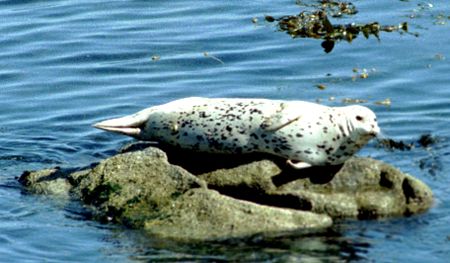|
Harbor
Seals
|
|
 |
|
|
Harbor seals are often seen popping their heads out of the water as well as lounging on the warm beach sands and rocks in Avila. From the pier it is hard to see them due to their natural blending coloring. Similar to all other mammals in the sea, any physical contact is restricted due to strict government law and thus limits research options for the pier. Scientific Classification
Physical Characteristics Male harbor seals reach sizes up to 6.5 feet in length and 375 pounds while females are a little bit smaller reaching lengths up to 5.5 feet and 330 pounds. Harbor seals range in color from light gray to silver with dark spots. Some are black, dark gray, or brown with white rings. Spots or rings are numerous on the dorsal or back side and more sparse in the ventral or underside. Some of the key traits of all species of pinnipeds include vibrissae, or whiskers found on either side of the animals head. These vibrissae each can move independently and have their own blood supply. Harbor seals also have hair covering their entire body, including their flippers. They use their hind flippers to propel themselves through the water with a side-to-side motion. On land, they move by undulating in a caterpillar-like motion. Harbor seals molt or shed their hair in patches each year after breeding season. This usually lasts about one to two months. Based on observations on zoological environments, harbor seals generally seem to decrease their food intake during molting. Behavior Unlike most pinnipeds, adult harbor seals are usually solitary and rarely interact other than to mate. If touched by another seal, they respond with growling, snorting, aggressive flipper-waving, head-butting, scratching, or biting. Although, harbor seals are often found sharing haul-out space with other pinnipeds, such as California sea lions and Northern elephant seals. While on land, harbor seals rarely move from one location. They remain alert and wary, however, and turn their heads frequently to watch for potential danger. Harbor seals are probably the least vocal of all pinnipeds. They usually vocalize only when they feel threatened; they may snort, hiss, growl, or sneeze. Conservation Issue Similar to all other mammals, harbor seals are protected by law. The U.S. Marine Mammal Protection Act of 1972 made it illegal to hunt or harass any marine mammal in U.S. waters. The primary objective of the MMPA is to maintain the health and stability of the marine ecosystem and to maintain an optimum population of marine animals.
|
